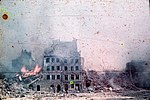| Polish resistance during World War II | |||||||||
|---|---|---|---|---|---|---|---|---|---|
| Part of Resistance during World War II and the Eastern Front of World War II | |||||||||
    Sequentially from top: soldiers from Kolegium "A" of Kedyw on Stawki Street in Wola district, during the Warsaw Uprising, 1944; Jewish prisoners of Gęsiówka concentration camp liberated by Polish Home Army soldiers from "Zośka" Battalion, 5 August 1944; Polish partisans of "Jędrusie" unit in Kielce area, 1945; Old Town of Warsaw in flames during Warsaw Uprising | |||||||||
| |||||||||
| Belligerents | |||||||||
(1939–1941; after 1944 against non-Communists only) (1943–1945) |
and others... Supported by:
| ||||||||
| Commanders and leaders | |||||||||
| |||||||||
| Strength | |||||||||
| 1,080,000 (1944) |
650,000 (1944)[1] ~200,000 | ||||||||
| Casualties and losses | |||||||||
|
| ||||||||
In Poland, the resistance movement during World War II was led by the Home Army. The Polish resistance is notable among others for disrupting German supply lines to the Eastern Front (damaging or destroying 1/8 of all rail transports), and providing intelligence reports to the British intelligence agencies (providing 43% of all reports from occupied Europe). It was a part of the Polish Underground State.
Cite error: There are <ref group=lower-alpha> tags or {{efn}} templates on this page, but the references will not show without a {{reflist|group=lower-alpha}} template or {{notelist}} template (see the help page).
- ^ Krzysztof Komorowski (2009). Boje polskie 1939–1945: przewodnik encyklopedyczny (in Polish). Bellona. p. 6. ISBN 978-8373993532.